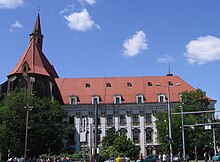St. Vincent (Wroclaw)
The St. Vincent Church in Wroclaw (pl. Katedra Greckokatolicka pw. Świętych Wincentego i Jakuba ) has been the cathedral of the Wroclaw-Danzig Eparchy of the Greek Catholic Church since 1999 . The church was built after 1234 as a Franciscan church and consecrated to St. James . In 1530, the church was handed over to the Premonstratensians as a replacement for their St. Vincent's Monastery on the Elbing, which had been demolished. Dedicated to Vincent . After the secularization of the St. Vincent Monastery in 1810, it served as a parish church.
The church is one of the city's major attractions. It is located on Plac Biskupa Nankiera (until 1945 Ritterplatz ) in the old town, about 500 meters northeast of the Wroclaw City Hall .
history
The first church was built after 1234 as a monastery church for the Franciscans appointed by Duke Heinrich II "the pious" from Prague as a ducal foundation. After the Duke's death in 1241, the building was completed by his widow, Duchess Anna of Bohemia . Duke Heinrich II was buried in the church choir .
On December 12, 1261, Duchess Anna of Bohemia and her sons announced in the Church of St. Vincent the granting of city rights for the new town of Breslau according to Magdeburg law .
In the 14th century the church was rebuilt in the Gothic style; the main nave has since been 77.5 meters long and 23 meters high. In 1530 the monastery was taken over by the Premonstratensian choristers, whose original monastery on the Elbing in front of the city wall (there since 1180/93) had been demolished for military reasons. In the years 1662 to 1674 the church received a baroque interior , including the high altar , which was created in 1667 by Franz Zeller and Georg Czermak.
In 1810 the Premonstratensian monastery was closed. Subsequently the church served as a Roman Catholic parish church.
At the end of the Second World War , the church was badly damaged. Then it was taken over by the Polish state, which wanted to set up a museum in it. The reconstruction work lasted until 1991. In 1997 the church was handed over to the Greek Catholic Church by Pope John Paul II and Archbishop Henryk Roman Gulbinowicz of Wroclaw . An extensive restoration took place between 1997 and 2010.
Hochberg Chapel
The Hochberg'sche Chapel ( Kaplica Hochberga ) was created from the reconstruction of the Marienkapelle from the beginning of the 14th century. In 1723–1727, the Premonstratensian Abbot Ferdinand von Hochberg had a baroque mausoleum built to serve as his burial place. The chapel is one of the masterpieces of the Wroclaw Baroque. The design comes from Christoph Hackner . In the artistic design were u. a. the sculptor Johann Albrecht Siegwitz from Bamberg , the Bohemian Johann Georg Urbansky , the stonemason Johann Adam Karinger and the Italian plasterer Ignaz Albrecht Provisore were involved. In the altar was a pietà from the 15th century, which is now on display in the Wroclaw National Museum .
The Hochberg Chapel was also destroyed in the Second World War, and it was faithfully restored between 2000 and 2013.
Tombstones and epitaphs
In the church there are tombstones and epitaphs for the abbots
- J. Thiel († 1545)
- Chr. I. Reuss († 1558)
- Kaspar Schröder († 1625)
- Martin Konrad († 1618)
also for
- Wilhelm Borek von Rostropitz († 1641), Governor of the Principality of Wroclaw
- Martin Maximilian von Wackerle († 1705)
literature
- Dehio Handbook of Art Monuments in Poland. Silesia. Deutscher Kunstverlag, Munich a. a. 2005, ISBN 3-422-03109-X , pp. 1070-1072.
- Izabella Gawin, Dieter Schulze, Reinhold Vetter: Silesia: German and Polish cultural traditions in a European border region. DuMont Art Travel Guide, DuMont Verlag, Cologne 1999, ISBN 3-7701-4418-X , p. 103.
Web links
- Restoration of the portal of the Vinzenzkirche 2008 (PDF; 1.8 MB)
Individual evidence
- ^ Pietà, Breslau workshop. Retrieved September 13, 2019 .
- ↑ Historical and current recordings of the Hochberg Chapel
- ↑ Completion of the Hochberg Chapel (Polish) (accessed on October 11, 2015)
- ↑ cf. Anna Judith von Boreck and Tworkau, baroness. Entry at WorldHistory.de.
- ^ Martin Maximilian von Wackerle. Inscription of the epitaph at Find A Grave.
Coordinates: 51 ° 6 ′ 46 ″ N , 17 ° 2 ′ 17 ″ E



